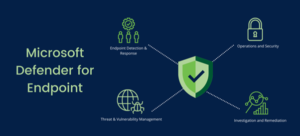Microsoft Defender for Endpoint is a powerful enterprise-grade solution designed to secure devices across your organization. With growing cyber threats and remote workforces, it’s essential to choose the right protection plan. This guide breaks down the features, plans, and value—so you know exactly what you’re paying for in 2025.

What Is Microsoft Defender for Endpoint?
Defender for Endpoint is Microsoft’s cloud-delivered endpoint security solution. It includes capabilities such as next-gen antivirus, endpoint detection and response (EDR), threat analytics, vulnerability management, and attack surface reduction. It’s designed to protect devices running Windows, macOS, Linux, Android, and iOS.
Plan Breakdown: Defender for Endpoint P1 vs. P2
Microsoft offers two primary plans to fit different security needs and budgets:
Plan 1 (P1)
Best for: Organizations seeking core prevention
Key Features:
Next-gen antivirus (NGAV)
Attack surface reduction
Manual response tools
Included in: Microsoft 365 E3
Standalone price: ~$3/user/month
Plan 2 (P2)
Best for: Enterprises requiring full EDR and automation
Additional Features:
Endpoint detection and response (EDR)
Automated investigation and remediation
Threat analytics and Microsoft Threat Experts
Included in: Microsoft 365 E5
Standalone price: ~$5.20/user/month
Understanding Microsoft Defender for Endpoint Pricing
Now let’s focus on Microsoft Defender for Endpoint pricing, which remains highly competitive in 2025. While Plan 1 offers essential protection, Plan 2 delivers advanced features needed by security-conscious organizations. Both are available as standalone solutions or bundled with Microsoft 365 subscriptions.
For companies already using Microsoft 365 E3 or E5, the inclusion of Defender can reduce total cost of ownership significantly. Microsoft also offers volume licensing discounts through CSPs and enterprise agreements—ideal for larger deployments.
Additional Licensing Notes:
Defender for Endpoint can be added to Microsoft 365 Business Premium
Supports hybrid environments, integrating with third-party SIEM and XDR platforms
Flexible monthly billing for standalone licenses
Competitor Comparison
When compared to top competitors like CrowdStrike and Sentinel One, Defender for Endpoint offers strong value—especially if your organization is already embedded in the Microsoft ecosystem.
| Feature | Defender P1 | Defender P2 | CrowdStrike | SentinelOne |
| Antivirus | ✅ | ✅ | ✅ | ✅ |
| EDR | ❌ | ✅ | ✅ | ✅ |
| Automated Response | ❌ | ✅ | ✅ | ✅ |
| Price/User | ~$3 | ~$5.20 | ~$8–$16 | ~$6–$12 |
Defender’s deep integration with Azure Active Directory, Microsoft Intune, and Microsoft 365 makes it easy to manage from a unified security dashboard.
Why Choose Defender for Endpoint?
Modern businesses need more than just antivirus. They require real-time insights, threat detection, and automated remediation. Defender for Endpoint delivers all that—without needing multiple third-party tools. The pricing reflects a strong ROI, especially when bundled with existing Microsoft licenses.
Conclusion
Choosing the right endpoint protection depends on your risk level, compliance needs, and internal IT capabilities. Microsoft Defender for Endpoint pricing, when evaluated alongside its native integrations and features, proves to be a smart investment for organizations prioritizing security and scalability.
Explore more digital security innovations with Digital Arches—where precision and protection go hand in hand.